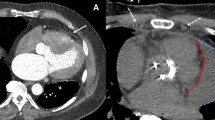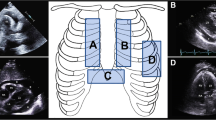Abstract
High-density pericardial fluid may be seen on noncontrast CT performed following cardiac catheterization (CC), raising the possibility of hemopericardium. Our goal was to determine the clinical course and associations of incidentally discovered high-attenuation pericardial fluid on noncontrast CT performed soon after CC. Hospital database search over a 7.5-year period identified 211 patients who underwent CT of the chest and/or abdomen within 60 h before or after CC, 150 having CC first. Pericardial fluid volume and attenuation as well as relevant laboratory and clinical parameters were recorded. Bivariate associations with average pericardial fluid attenuation (HUavg) were assessed. Using the 61 patients with CT before CC as controls, 44 of the patients with CC first had attenuation values greater than the mean + 2SD of 22.6 Hounsfield unit (HU) and 19 had attenuation values greater than the maximum control patient value of 39.8 HU. All patients with incidental finding of high-density pericardial fluid followed a benign course. Bivariate correlations showed time gap between CC and CT (rho = −0.50, p < 0.001), estimated glomerular filtration rate (eGFR) (rho = −0.24, p = 0.004), and female gender (median (IQR) 17.4 (13.6, 29.6) vs. 15.8 (9.9, 23.7), p = 0.02) to be associated with HUavg. In multiple linear regression analysis, only time gap and female gender were independently significantly associated with average attenuation (both p < 0.001). The finding that patients with incidentally discovered high-density pericardial fluid followed an uneventful course suggests a benign etiology such as vicarious excretion, and in patients who are otherwise stable, observation rather than immediate intervention should be considered.



Similar content being viewed by others
References
Lee R, Matsutani N, Polimenakos AC et al (2007) Preoperative noncontrast chest computed tomography identifies potential aortic emboli. Ann Thorac Surg 84(1):38–41
Nishi H, Mitsuno M, Tanaka H et al (2010) Who needs preoperative routine chest computed tomography for prevention of stroke in cardiac surgery? Interact Cardiovasc Thorac Surg 11(1):30–33
Bellin E, Fletcher DD, Geberer N et al (2010) Democratizing information creation from health care data for quality improvement, research, and education—the Montefiore Medical Center experience. Acad Med 85(8):1362–1368
National Kidney Foundation (2002) K/DOQI clinical practice guidelines for chronic kidney disease: evaluation, classification, and stratification. Am J Kidney Dis 39(2 Suppl 1):S1–S266
Broderick LS, Brooks GN, Kuhlman JE (2005) Anatomic pitfalls of the heart and pericardium. Radiographics 25(2):441–453
Roberts WC (2005) Pericardial heart disease: its morphologic features and its causes. Proc Baylor Univ Med Cent 18(1):38–55
Wang ZJ, Reddy GP, Gotway MB et al (2003) CT and MR imaging of pericardial disease. Radiographics 23:S167–S180
Escher DJ, Shapiro JH, Rubinstein BM et al (1958) Perforation of the heart during cardiac catheterization and selective angiocardiography. Circulation 18(3):418–422
Widimský P, Gregor P (1995) Pericardial involvement during the course of myocardial infarction. A long-term clinical and echocardiographic study. Chest 108(1):89–93
Tomoda H, Hoshiai M, Furuya H et al (1980) Evaluation of pericardial effusion with computed tomography. Am Heart J 99(6):701–706
Kamath S, Roobottom CA (2005) Hyperdense pericardial effusion in dermatomyositis and contrast induced nephropathy. Emerg Radiol 11(3):177–179
Hopper KD, Weingast G, Rudikoff J et al (1988) Vicarious excretion of water-soluble contrast media into the gallbladder in patients with normal serum creatinine. Invest Radiol 23(8):604–608
Holloway H, Nance EP, Burks D et al (1985) Vicarious excretion of contrast medium in patients without azotemia. Urology 25(2):201–203
Lautin EM, Friedman AC (1982) Vicarious excretion of contrast media. JAMA 247(11):1608–1610
Minutoli A, Volta S, Gaeta M (1989) Delayed enhancement of ascites following high-dose contrast CT for liver metastases. J Comput Assist Tomogr 13(5):916–917
Benedetti N, Aslam R, Wang ZJ et al (2009) Delayed enhancement of ascites after i.v. contrast material administration at CT: time course and clinical correlation. AJR Am J Roentgenol 193(3):732–737
Cooper C, Silverman PM, Davros WJ et al (1993) Delayed contrast enhancement of ascitic fluid on CT: frequency and significance. AJR Am J Roentgenol 161(4):787–790
Hammerman AM, Oberle PA, Susman N (1990) Opacification of ascitic fluid on delayed contrast computed tomography scans. Clin Imaging 14(3):221–224
Meholic AJ, Davis M, Bonmati C (1991) Vicarious gastric excretion of intravenous contrast. Am J Physiol Imaging 6(4):197–200
Becker JA, Gregoire A, Berdon W et al (1968) Vicarious excretion of urographic media. Radiology 90(2):243–248
Acknowledgments: funding for H.W.C.
This publication was supported in part by the CTSA Grant UL1RR025750, KL2RR025749, and TL1RR025748 from the National Center for Research Resources (NCRR), a component of the National Institutes of Health (NIH), and NIH roadmap for Medical Research. Its contents are solely the responsibility of the authors and do not necessarily represent the official view of the NCRR or NIH.
Conflict of interest
The authors declare that they have no conflict of interest.
Author information
Authors and Affiliations
Corresponding author
Rights and permissions
About this article
Cite this article
Avery, L.L., Jain, V.R., Cohen, H.W. et al. High attenuation pericardial fluid on CT following cardiac catheterization. Emerg Radiol 21, 381–386 (2014). https://doi.org/10.1007/s10140-014-1211-7
Received:
Accepted:
Published:
Issue Date:
DOI: https://doi.org/10.1007/s10140-014-1211-7




